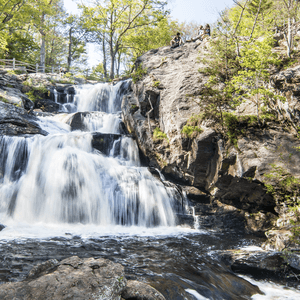You are here
Air Line State Park is an approximately 50-mile long rail trail that stretches across northeastern Connecticut. It’s divided into a south section (23 miles from East Hampton to Windham), a north section (21 miles from Windham to Putnam), and the Thompson addition (6.6 miles from Thompson to the Massachusetts state line). Today, the trail welcomes bikers, walkers, and horseback riders on a shallow-grade path that varies between dirt, asphalt, and gravel.
The oldest beds were built in the 1870s and once offered rapid transit from New York City to Boston. By 1873 it serviced New Haven to Willimantic and linked with other railroads to connect these two major cities. At the time of its creation, this rail project was controversial due to challenging obstacles such as the Connecticut River and miles of sharp ridges, factors that would later lead to its decline. These physical curves and inclines forced the railroad to limit the speed and weight of passenger and freight traffic, which could not meet the demands of the bustling transportation industry.
This section of the trail offers parking on Highway 203, Back Road, South Brook Road, Potter Road, and several other locations. The standard rules are to keep to your right and call out before passing. Upon approaching horses, bicyclists are asked to dismount and ask the equestrian if it is safe to pass. Also, please respect the private properties along the trail and do not trespass. Additional information about each town’s section can be found on the Department of Energy and Environmental Protection.
Air Line State Park is part of the East Coast Greenway trails system, a multi-purpose trail connecting cities from Florida to Canada along the East Coast.
The Connecticut Department of Energy and Environmental Protection (DeeP) provided the park land and the local towns contribute to the necessary maintenance and labor services. In 2002 the United States Department of the Interior designated the southern East Hampton to Windham section as a national recreational trail, and it now receives funding for materials from the National Recreational Trails Act. Local volunteers also help maintain the trail, and if you are interested in participating, contact your local parks and recreation department.
Logistics + Planning
Current Weather: Powered by Dark Sky

































Comments
Sign In and share them.